A reverse proxy server acts like a trusted librarian, storing up-to-date copies of all your content and loaning it out, securely, to those who request it.
Reverse Proxy for Newbies
There’s a lot of complicated explanations for how proxies work. So we’re going to distill things into a hopefully, easier to understand article, with a few advanced features explained at the end.
What is a reverse proxy?
Often referred to as a reverse proxy server, what is really meant, is a server that contains the reverse proxy instructions. A reverse proxy set of instructions for a server tells it how to handle the following content requests from other servers:
- servers in communication with a client browser - for those who look up websites at home or work.
- and servers that host a website on behalf of any website provider - websites owned by network administrators and business owners, blog owners, application providers like streaming websites, office app creators, social media feeds, and anyone who puts content onto the internet via a website.
What is a Proxy Server?
A
proxy server separates people who browse the internet from the websites they browse. Or to put this a simpler way, it hides the client from the web.
An example of a proxy server in action
When you connect to the internet on your work computer, you might not realize you gain access to the internet via a proxy server. The proxy server hides your workstation IP address and the response displays the company proxy server’s IP address instead when you are online.
This layer of security and privacy is essential to protect individuals but also give them authentication as they browse websites from all over the world.
Proxy servers and hosting
When you buy hosting for your website, you now have a proxy server dedicated to your website.
The proxy server IP address disguises yours, providing a layer of privacy. You can still update and store your website at home or at the office, but the difference is these IP addresses are not disclosed on the internet. Instead, the proxy server IP address is visible to the public.
Proxy servers are configured to hide the identity of their clients, acting as an address-based firewall. Other interesting proxy features include being able to identify rogue websites and filter them, provide shared network connections safely to your employees or family (internal clients), and cache/store the latest website data to speed up common requests.
Forward proxy flow. From internal clients to the internet, to requesting external servers.
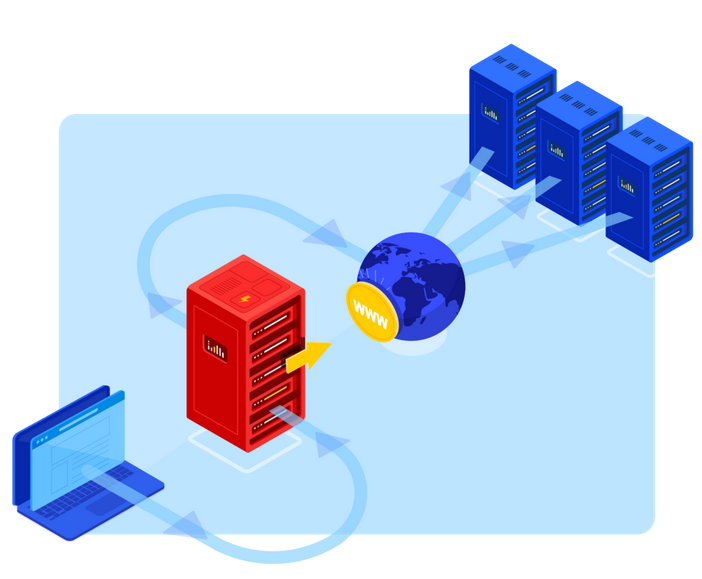
Remember a proxy keeps you safe online by hiding your website IP address. Your proxy server address is not your
household or office IP address where, after all, you might be updating content, sending important documents, and doing money transactions. You don’t want unwanted eyes on there.
Reverse Proxy vs Forward Proxy
A reverse proxy takes on the role of answering people requesting your content instead of the hosting server.
For example, in the case where many people want to see a copy of your website, or part of your website, simultaneously, your proxy server gets really busy trying to answer. Imagine a live-streaming theatre performance, as an example. There are many requests. A Reverse proxy solves this problem for a hosting server because it constantly updates the live stream (known as ‘dynamic content caching’). In today’s world where the internet is busy delivering ever more complex content, a reverse proxy takes the load off a hosting server
Handling incoming, or ingress requests from the outside world can be delegated to a reverse proxy.
A forward proxy flow. (up) A reverse proxy flow. (down)
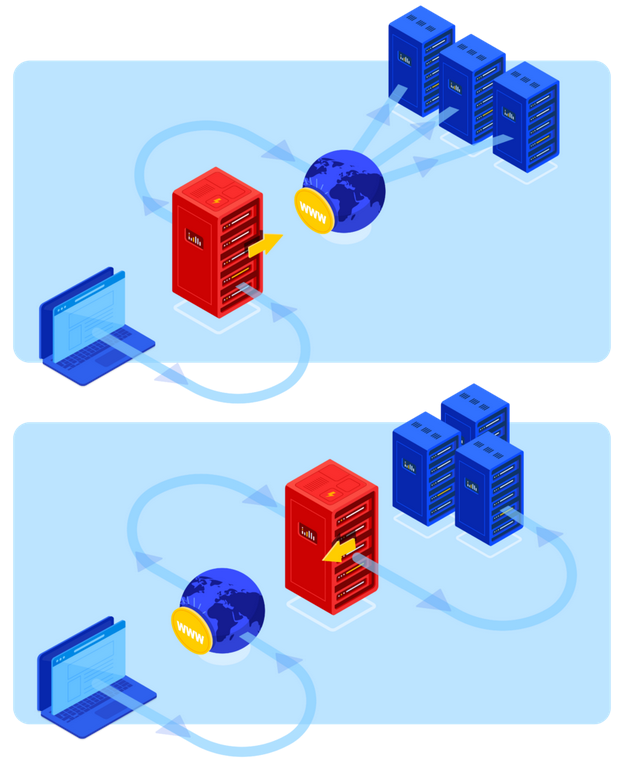
Remember, both kinds of proxy can look up content and handle requests.
How do I Get a Reverse Proxy to Work?
Picture your website gaining more traffic. A reverse proxy kicks into play a type of ‘function’ directing traffic super-safely between clients and your hosting server. A reverse proxy is designed to balance the increase in requests for information. Refer to picture 2 as shown above and reverse proxy flow.
This is why website owners with high traffic sites and/or sites with lots of content need a better delivery system than just one or two hosting servers. Adding a global network of servers with reverse proxy functions, able to handle simultaneous requests from all around the world, means the heavy lifting is dispersed and balanced across many servers.
A reverse proxy flow:
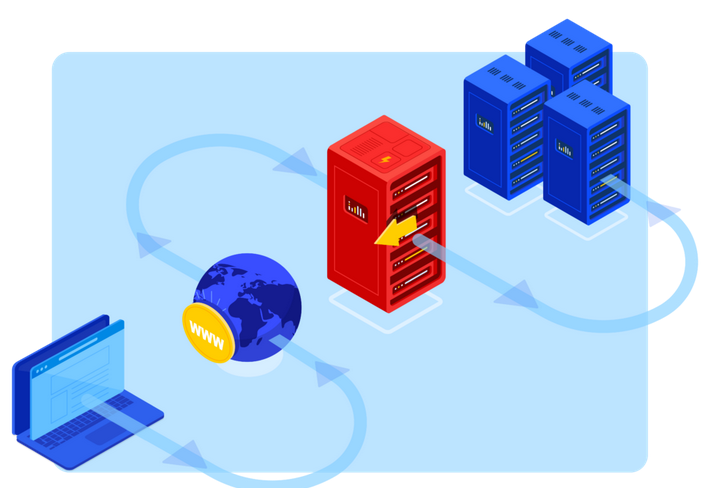
From requesting clients/servers (L) to the internet, to the reverse proxy server, who asks the internal client servers/hosting (Right) for content, which is then served and stored on the reverse proxy server and delivered back to the requestors.
Of course, the most effective way to distribute content blazingly fast with proxies and reverse proxies is within a CDN (
Content Delivery Network).
How CDNs Use Reverse Proxies
A CDN is best thought of as an internal network service. You might have heard a CDN described as many multiple servers all over the world who securely store all of your website content and then deliver it to anyone who requests it from anywhere. This is all true, of course, but we can simplify the idea if we imagine it (below) as a series of pins stuck on to a map of the world.
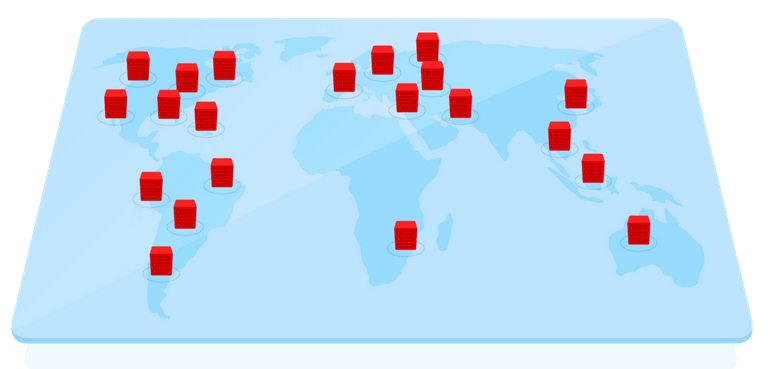
In our example, CDN edge servers are located at these pinned sites around the world.
A CDN connects itself to these edge servers all over the world forming a network that works privately. Within the CDN, lie proxy and reverse proxy instructions which are as clever as the provider you bought it from. These instructions tell those edge servers how to store your website, handle content requests in the most efficient way, and all the while protect your privacy and the privacy of your customers. You can read more about
how a CDN works here.
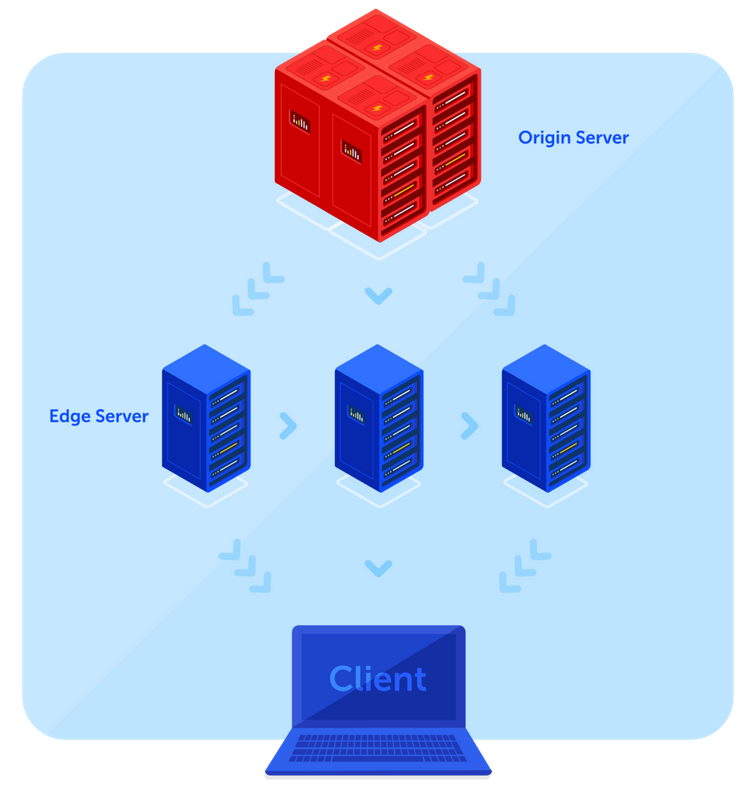
Both forward and reverse proxy flows work together in a CDN through edge servers.
The most effective way to control requests and optimize hosting power is through an easy-to-administer CDN service, like
Namecheap’s Supersonic CDN. You can simply turn it on, letting processes run automatically, or go high-octane on an advanced plan and drive the controls for your company.
The reverse proxy function provides the following benefits
Implementing reverse proxies via a CDN makes sense for any website handling a large number of requests daily.
Protection. Directing traffic requests means Distributed Denial of Service (DDoS) attacks are mitigated. The reverse proxies disguise all domain names and personal IP addresses through sophisticated routing code. It doesn’t matter if your website users are retrieving app content, on their mobile phone, or watching a video live-streamed from another platform, the layer protects everyone against all URL address injection-based cybercrime. It’s also easier to remove malware from your network as it gets trapped by the reverse proxy server it first encounters.
Caching. Once a CDN handles a website visitor, a reverse proxy function tells the edge servers about this visit and the content details. Almost instantly, all edge servers remember the visitor and the content. It’s like every edge server in the CDN network is in on the secret. Known as caching, within seconds, the content just one visitor saw is now proactively stored everywhere. So this then arrives, lightning-quick, for everyone. Caching comes in handy when thousands of people look up your website simultaneously from all over the world.
Load balancing - of course, a key part of the special instructions operating within a reverse proxy geo-directs global visitors to the nearest edge server. Known as load balancing, the reverse proxy way of looking at all those visitors is to recognize when part of the CDN edge server network is heavy with traffic. It adjusts requests and sends some of them to the next closest geographical server. The great benefit is that your website won’t experience downtime, even if you are for example, streaming a live theatre performance.
SSL encryption - Reverse proxy servers can be configured to tell your SSL certificate how to handle all incoming and outgoing users.
Top Tip - What to spend on a CDN
One thing to appreciate is the larger the CDN network, the more resilient it is to traffic surges and the more capable it is to serve simultaneous requests. If you wish to buy a CDN, it is a good idea to work out the size of your traffic/visitor needs. Otherwise, you could overspend.
Another factor to consider is when a CDN provides good value. Enterprises see lower administration costs if using reverse proxy setups because the global server infrastructure and technology staff needed to maintain things are outsourced. You don't need to buy a network of global servers or the technical staff to maintain it.
How to implement a reverse proxy
You can leverage a global network with a CDN, and simply ‘set and forget’, reaping the benefits, or if you want to be more hands on, drive the controls. Remember, by working at the edge of a network CDN, reverse proxies increase the speed and security of your website. CDN analytics helps you analyse the performance of your website. For your visitors, a CDN means they can always find your content, fast. It’s simply, a better, faster website.
How Can Namecheap Help?
The best way of taking advantage of proxy and reverse proxy technology is through a CDN.
Namecheap’s Supersonic CDN employs reverse proxies acting as an intercept between users looking up your website and your internal proxy hosting server. Our CDN edge servers around the world intensify the speed of content delivery and provide multiple-layer security effects.




